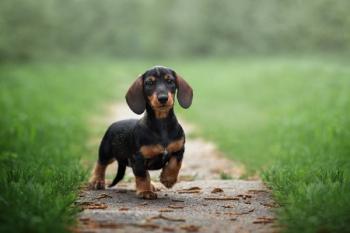
CVC highlight: The hunt for grass awns
When to suspect and how to extract these irritating foreign bodies.
Migrating plant foreign bodies, which are seen most commonly in hunting dogs, cannot only be uncomfortable, but can also quickly cause serious health problems. Here is when to suspect such foreign body invasion and how to eliminate the unwanted invaders.
How they get in
Grass awns and plant material are thought to enter the mouth or nose when a dog is breathing hard as it runs through a field. The plant material can migrate through the respiratory or gastrointestinal tract or other tissues, or it can penetrate through the skin and migrate elsewhere. Grass awns have backward-pointing barbs that prevent retrograde movement. This makes normal clearing mechanisms ineffective, and grass awns will migrate deeper with normal motion.
What owners may notice
Clinical signs will depend on the location of the plant material. The most common location is the ear, and clinical signs are often those of otitis externa. Patients may have an interdigital swelling or a draining tract when the paw is affected. Lumbar pain or swelling and pain at the costal region caudal to the last rib may be present if an abscess has developed. Other signs of a plant foreign body include a superficial abscess that is drained and treated with antibiotics but then recurs soon after the antibiotics are finished. Increased respiratory effort or dyspnea when a pyothorax is present may be seen. Signs can also be vague, such as decreased performance, decreased exercise tolerance, lethargy, fever, and weight loss.
The concurrent bacterial invasion-and how to attack it
Infection associated with migrating grass awns is often a mixed population of bacteria. Grass awns become inoculated with commensals of the oral cavity and respiratory tract when they enter via these routes. Common organisms found include Staphylococcus, Streptococcus, and Pasteurella species and Escherichia coli. Actinomyces and Nocardia species (soil-borne organisms) are also often associated with grass awns and are seen as filamentous rods on cytologic examination of fluid. They can be difficult to culture, particularly if antibiotics have been administered before obtaining the sample. Therefore, any patient that has a confirmed migrating grass awn but a negative culture result should still be considered to have a bacterial infection and be treated empirically, making sure that antibiotics chosen are appropriate for Actinomyces and Nocardia species.
Penicillin derivatives are generally a good first choice. I typically start with amoxicillin-clavulanic acid orally or amoxicillin-sulbactam intravenously. Administer the antibiotics long-term-four to eight weeks depending on the primary problem-but for no less than four weeks. If culture results do show growth, base your antibiotic selection on the sensitivity.
The real hunt begins-and the tools to conquer
A migrating grass awn should be high on your differential list for any hunting dog showing the clinical signs previously mentioned. Physical examination findings (e.g. a subcutaneous abscess, pain on lumbar palpation, decreased lung sounds) will narrow where to look for the problem. A baseline complete blood count may demonstrate a leukocytosis. Imaging will be the most beneficial diagnostic tool. The goals to achieve a successful outcome are removal of the foreign body, débridement and drainage of infected tissue, and long-term antibiotic therapy.
> Abscesses
For abscesses in hunting dogs, ultrasonographic examination has been extremely useful in identifying and confirming a foreign body in our clinic. A skilled ultrasonographer who has experience locating this type of foreign body can help the surgeon know its exact location using anatomical landmarks and give information regarding the size of the foreign body and whether multiple foreign bodies are present. If locating it intraoperatively is difficult, intraoperative ultrasonography can be performed. Once the foreign body is located by ultrasound, a needle can be inserted with ultrasonographic guidance to pinpoint its location.
> Respiratory migration
For dogs presenting with respiratory signs, thoracic radiography often reveals pleural effusion, and thoracocentesis is performed to analyze the fluid. Fluid analysis helps in the diagnosis of pyothorax in many of these cases.
A variety of treatment regimens have been recommended, including thoracocentesis, thoracic drain placement with lavage, and thoracotomy. Determining which treatment is appropriate depends on many factors.
If the foreign body has been present for some time, significant loculation can occur from fibrinous deposits that results in the formation of fluid pockets that can be difficult to drain, leading to failure of medical management. Surgical exploration and dbridement of the thoracic cavity through a median sternotomy is often recommended in these cases. A foreign body is rarely found, but the dbridement and lavage is beneficial in resolving the pyothorax. Leave thoracic drains in place after the surgery to facilitate continued lavage and drainage of the thorax.
Surgery is also indicated if a pulmonary abscess, lung lobe torsion, Actinomyces species, or a foreign body is identified. Ultrasonographic examinations or computed tomography scans of the thoracic cavity can be helpful in identifying these pathologic conditions.
What if you cant find it?
For cases in which the foreign body cannot be found, the best approach is drainage of infected fluid, dbridement of associated tissue, placement of a drain, and long-term antibiotic therapy. In cases such as these, antibiotic therapy should be administered for at least eight weeks. The hope in these situations is that the body will wall off the foreign body and that surgical drainage or dbridement and long-term antibiotics will control the infection. However, these cases are at risk for recurrence, particularly after the antibiotic regimen is complete, and owners should be vigilant in watching for return of clinical signs. Also, dont forget that the grass awn could have migrated elsewhere, and that might be why it couldnt be found.
Newsletter
From exam room tips to practice management insights, get trusted veterinary news delivered straight to your inbox—subscribe to dvm360.





